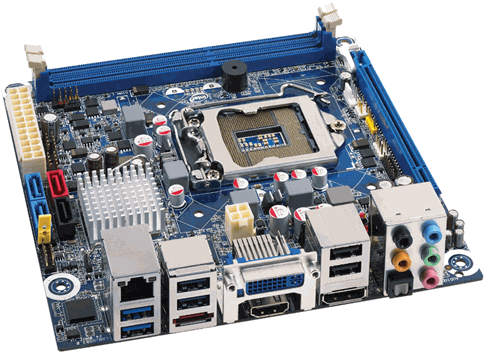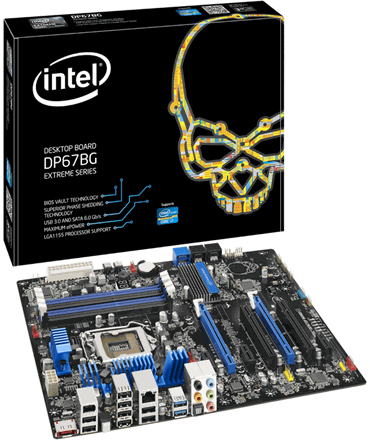SPONSORED BY Intel - Intel Inside, Including the Motherboard?

Why Buy an Intel Motherboard?
The market is brimming with motherboard options, and businesses of all sizes face the unenviable task of trying to decide which vendor to place at the heart of their productivity desktops. One vendor will offer more features. Another might offer better power efficiency while a third touts superior performance.
To some degree, these factors are all icing on the cake. At the end of the day, a work system only must do one thing: work. Stability is king. Once that has been assured, then it makes sense to consider secondary concerns, such as features, form factors, and (in business settings) manageability.
The key to a motherboard’s stability and performance lies in its processor and chipset. Intel has led the market in both of these components for many years. According to Mercury Research, Intel held 81% of the processor field at the end of this year’s first quarter, a position the company retains in large part from its unmatched R&D, which allows it to stay ahead of competitors. This R&D not only helps Intel to create the most advanced product architectures, it also gives the company more time to dovetail those architectures with complementary products, especially motherboards.

This only makes sense: when you need to test a new processor and chipset, you need a motherboard on which to test them. The longer and more thorough learning gained in this process gives Intel an immediate advantage on motherboard quality and reliability as well as the ability to refine motherboard architectures to better mesh with the latest chip developments. An example of this is the new LGA1155 socket designed for the latest generation of “Sandy Bridge” 2nd generation Intel Core processors. Another might be the new Smart Response Technology (SRT) method of using an SSD (such as the newly launched 20 GB SLC Intel 311 drive) as hard drive cache under an Intel Z68 chipset.

The end result of this cooperative development cycle is that businesses and consumers alike get the most stable, reliable motherboards available when they buy Intel. In the following pages, we’ll get a closer look at why this is the case along with some of the secondary benefits Intel offers.
Intel In The Motherboard Business
Back in March 2009, Tom’s Hardware ran an article showcasing 16 years of Intel motherboard development. In it, you can see Intel’s first commercial motherboard, the “Batman” model from 1993, designed for Pentium 60 and 66 processors. Prior to this, the company had only produced reference boards for manufacturing partners. By the mid-‘90s, though, Intel had cemented its place in the commercial motherboard market. This may have had something to do with the rise of Intel’s 430FX chipset as the most popular core logic of its day.
Stay on the Cutting Edge
Join the experts who read Tom's Hardware for the inside track on enthusiast PC tech news — and have for over 25 years. We'll send breaking news and in-depth reviews of CPUs, GPUs, AI, maker hardware and more straight to your inbox.
Another Intel makes sure that its motherboards are at the forefront of innovation and reliability is through helping to pioneer and ratify industry standards. Today, Intel works with over 250 standards and industry groups across a wide range of computing-related fields. Sometimes, Intel develops technologies internally and then turns them over to industry bodies. For instance, Intel started development on the Peripheral Component Interconnect (PCI) bus in 1990 within its own Architecture Development Lab. Two years later, the PCI specification migrated to the newly formed Peripheral Component Interconnect Special Interest Group (PCI-SIG). Intel still sits on the PCI-SIG’s Board of Directors, but the non-profit now boasts more than 800 member companies. In a similar way, Intel was one of seven companies, principally led by Intel’s Ajay Bhatt, that started work on the Universal Serial Bus (USB) in 1994. Now, USB is governed by the USB Implementers Forum. Intel did much the same with AGP and PCI Express. To drop just a few more names, Intel is deeply involved with the Digital Living Network Alliance (DLNA), DVD Forum, The Linux Foundation, Serial ATA International Organization, and the UPnP Forum.
All of this industry involvement and innovation translates into a wealth of new technologies for Intel to tie into its motherboard efforts. But exactly how these technologies become productized depends on a wide array of considerations. For starters, there are form factor concerns. How big should a motherboard be, and how much expansion capability should it offer? Options range from the slot-loaded Extended ATX down to the almost fully integrated Mini-ITX. Intel has been instrumental in helping design many of the industry’s form factor standards, as you can see at the company’s FormFactors.org site.
Then there’s the issue of target audience and application. Intel now offers six desktop motherboard families, never mind server, workstation, or embedded platform models. These start with the entry-level Essential Series SKUs (mostly based on G41chipset and integrated Atom processor models) and move all the way up to the top-end Extreme Series, supporting the latest LGA1366 processors alongside the X58 chipset. Businesses often opt for the Executive Series, preferring the management features found in Intel’s Q-series core logic.
-
Benihana I happen to be a grade-A idiot and now want to buy an Intel motherboard because this article presents data so well. Who else wants some free money?Reply -
trauquen someone said intel motherboard now is not designed by self, they are ODM products, not OEM products. is that truth?Reply -
Lutfij seriously, i'm beggingin to doubt my 2+ years membership at Tom's cos of this so called "article"Reply
I thought Tom's was engaged in bringing us groundbreaking reviews - not things to read when we need to go to sleep.
Face it intel - manufacturers are able to reverse engineer your boards and come out with tonnes of goodies with a slight bump in prices! Period! -
Lutfij Reply9515571 said:What kind of dumbass falls for these bullshit advertorials?
people who aren't enlisted on pc/tech forums and swindlers :P with this rubbish report even intel can fool its CEO into buying their crap :D -
CoolnQuiet Ahem, Mini-ITX was developed by VIA in 2002. Not by Intel! Who writes this nonsense?Reply -
My first and last intel board was purchased with my i3 core (gen1). Pure garbage after 6 months. Slow POSTs became non boots unless I started the machine and hit the reset button. Stick it sideways intel.Reply
-
Well, it's good that it says SPONSORED on the first page, as this could just as well have been written by Intel...Reply
Most Popular

